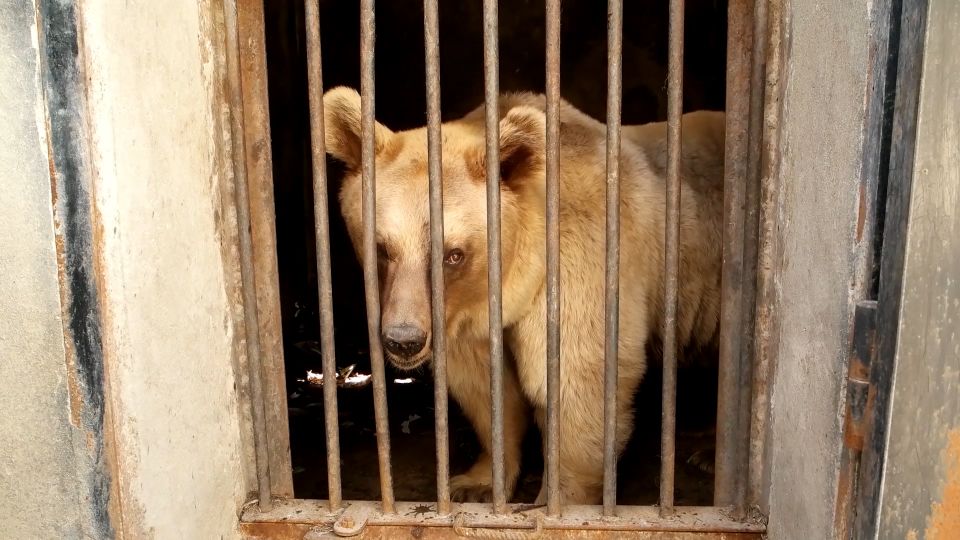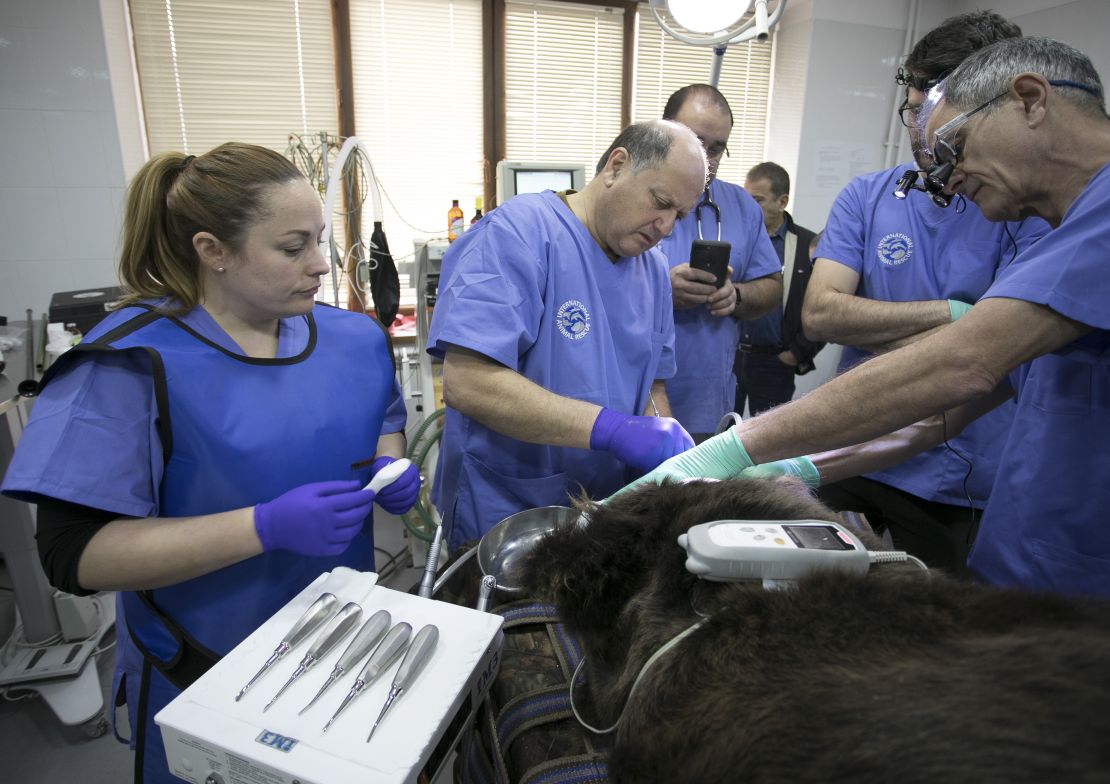Armenian Bears
Project Introduction
Every year wild bears are illegally caught or trapped by poachers in Armenia. Once captured, most end up in small, barren cages in public entertainment venues including restaurants, hotels and roadside zoos, as well as petrol stations and even factories. They are used as a tourist attraction and to make money out of captive breeding.
Wild bears in Armenia are Syrian Brown Bears (Ursus arctos syriacus), one of the smaller sub-species of brown bear. They are found in the mountainous areas of the country where they forage for fruits, berries and insects in the meadows and forests and hibernate in caves and tree hollows. Their man-made prisons are a far cry from their natural home in the forest.
Some are incarcerated for years in filthy, cramped cages with scarcely any food or water. Their environment meets none of their psychological or physical needs. They have very little space to move around and exercise and no enrichment to dispel their boredom and frustration. They lack everything they need to live life as nature intended.
In October 2017, working with Armenian group Foundation for the Preservation of Wildlife and Cultural Assets (FPWC), International Animal Rescue launched The Great Bear Rescue campaign to help these suffering bears. It was believed there could be as many as 80 bears kept privately in cages across Armenia.

The Wildlife Rescue Centre
The official opening ceremony of the Wildlife Rescue Centre (WRC) in Urtsadzor, Armenia, took place on 15 December 2017. The centre is located within the 20,000 hectares of the Caucasus Wildlife Refuge (CWR), managed by IAR’s partners FPWC. The two groups had previously joined together to rescue and rehabilitate three lions in an abandoned zoo in Gyumri. Now we had a new mission – to rescue brown bears kept in cages across Armenia.
The purpose-built centre can accommodate up to 15 rescued bears. It comprises spacious outdoor enclosures with bathing pools and underground dens, as well as quarantine quarters for new arrivals, a veterinary clinic and operating theatre. Cameras installed throughout the centre enable round-the-clock monitoring of the bears to ensure their safety and well-being.
The construction of the Bear Rescue and Rehabilitation Centre and the purchase of a fully equipped animal ambulance was made possible thanks to the support of International Animal Rescue, as well as FPWC’s general partners VivaCell-MTS, ARTIS Amsterdam Royal Zoo and the Ministry of Nature Protection of the Republic of Armenia.
Our Work
Rehabilitation
On arrival, many of the bears display abnormal (stereotypical) behaviour such as pacing to and fro, swaying, head tossing and circling incessantly. It takes them time to adjust to the larger space in the enclosures after being kept in confinement for so long. From the moment they are placed in the quarantine unit, the bears are provided with regular environmental enrichment to keep them occupied and try to break the cycle of stereotypical behaviour.
After eight weeks in quarantine and once declared free from disease, the bears are moved to an outdoor enclosure and their rehabilitation begins in earnest. They are kept under close observation to assess their progress and eventually, if they start to display wild bear behaviours such as foraging for food and hibernating during the winter months, they may be deemed suitable for release back into their natural habitat.

Dental surgery
Many of the rescued bears suffer from severe dental problems after years gnawing on the bars of their cages and a diet of leftovers and junk food. As with the rescued dancing bears in India, IAR’s volunteer dental team, led by veterinary dental specialist Gerhard Putter, along with IAR trustee and dentist Paul Cassar, makes regular visits to Armenia to treat the rescued bears. They carry out extractions and root canal surgery to relieve the bears’ pain and have also treated a number of animals in Yerevan Zoo, including a lion and a hyena.
Release
In May 2018, for the first time in Armenia, two rescued bears were released back into the forests. The two young bears, female Bambak and brother Zangak, had been orphaned the previous year when their mother was shot by a hunter. They were taken into the care of the Wildlife Rescue Centre in Urtsadzor.
During their time at the centre, the bears were kept in seclusion with very little human contact, enabling them to grow up in a semi-wild state and develop all the natural behaviours they would need to survive in the wild.
Once winter was at an end and a plentiful supply of food was available for the bears in the forest, plans were put in place to release the pair. A special GPS collar was made in the UK and fitted around Bambak’s neck so that the bears’ movements could be tracked during their first months of freedom. After six months the collar would unlock and fall off.
A year later, female bear Dasha and her two cubs Coco and Luca were returned to the wild. Dasha was one of the first caged bears to be rescued and, when she came out of hibernation at the centre, she had two small cubs at her heels. In May 2019 the little family followed in the footsteps of Bambak and Zangak when they too were returned to the wild.
How you can help
How you can help
-
Syrian Brown Bear Facts
- The Syrian Bear (Ursos arctos syriacus) is a sub-species of the Brown Bear (Ursus arctos.)
- It once ranged throughout the Middle East, as far south as the Sinai Peninsula. However, the bears were often viewed as pests or threats to human safety and were killed as a result.
- The killings, combined with loss of habitat through deforestation and subsequent desertification, led to a marked reduction in the bears’ range. Today the Syrian Bear still ranges from Turkey to Iran, including the Caucasus Mountains of Russia, Georgia, Armenia and Azerbaijan but is generally believed to be extinct in Syria, as well as neighbouring Lebanon.
- The Syrian brown bear sleeps and hibernates in caves and hollow trees.
- The female bear gives birth to up to three cubs during hibernation.
- They are omnivorous bears and search for food in forests, grasslands and meadows They eat almost any kind of available food, such as fruit, berries, seeds, insects and small mammals.
- The Syrian brown bear weighs up to 250kg and measures anywhere from 100 - 140cm from nose to tail. It is overall the smallest bear of the Ursus arctos species.
- The most common colour is a very light brown. The lighter colours usually appear at higher altitudes. They may have a dark brown patch on their heads, a white collar, and a dark stripe down the back. Their legs are commonly darker than the rest of their body. It is the only known bear in the world to have white claws.
- Status: Declining population; endangered. Overall however, listed as “of least concern” by the IUCN and on CITES Appendix II.
- Lifespan: In the region of 20 to 25 years in the wild.






